Snow Management At The Horse Farm
By Nikki Alvin-Smith
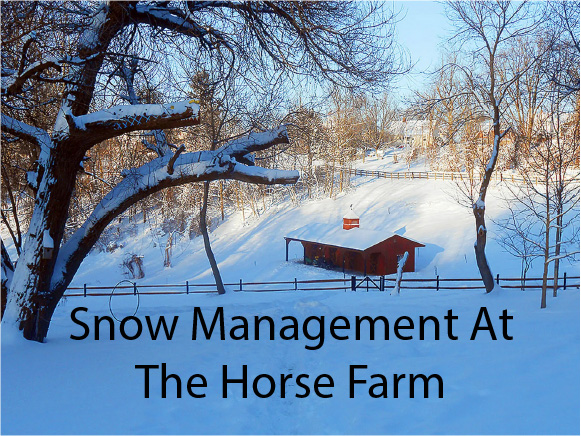
If you live in the colder regions of the U.S.A. winter heralds the arrival of more than the holiday season. It also harasses the horse owner with heaps of snow.
Access to the horse farm and the horse barn, can be hampered by mountains of snow and slippery ice. A carefully thought out snow management campaign involves understanding more than just the winter weather pattern.
Easy access to the barns, paddocks with a cleared driveway is important not just for daily chores and horse care, it is also imperative to keep the entry to all the facilities at the farm open for emergency care. Fire, flood, or wind damage may occur at the property at any time requiring heavy-duty vehicular ingress. Don’t forget a need for emergency medical care for horse and human may arise that also requires prompt access for personnel and transport equipment.
A Clear Road Ahead
The right tool for the job makes life easier whatever the task at hand. In the case of snow removal a professional service may be employed to handle the snow removal of large areas such as long driveways and expansive yards. Snow plows on pick ups with salters benched in the bed of the truck, or tractors equipped with snow throwers or plows can quickly move tons of snow.
Factors to consider when building your horse farm include allowance of plenty of space for equipment to turn around once they reach the horse barn, and the type of material laid on the driveway.
For example, if you lay attractive pea gravel on the driveway, it will end up on the grass verge or in the adjoining pasture when the snow removal task is executed. This will require more expense in the Spring to replace the material.
Snow throwers can also spray material a significant distance from the plow area, which can damage screens, glass windows and doors and siding.
A hard packed driveway is best for regions where consistent snow fall is expected.
Smaller areas such as entrances to barns, gates and paths to turnout paddocks, will require the use of smaller equipment. Investment in a snowthrower with either wheels or tracks (preferred if the terrain is hilly) is a wise choice to save backbreaking hand shoveling.
Turnout paddocks may need plowing out in regions with high snowfall amounts. It is fairly simple to run around the paddock with a tractor and snowthrower set on high, to make a few paths/routes so that the horses can better navigate high banks of snow. It is best to leave a layer of snow behind for traction, rather than take the plowing to the grass base. For the same reason, leaving the grass slightly longer to 6” or so in length across the entire property, will offer better traction in winter than grass that is mown down to just a few inches.
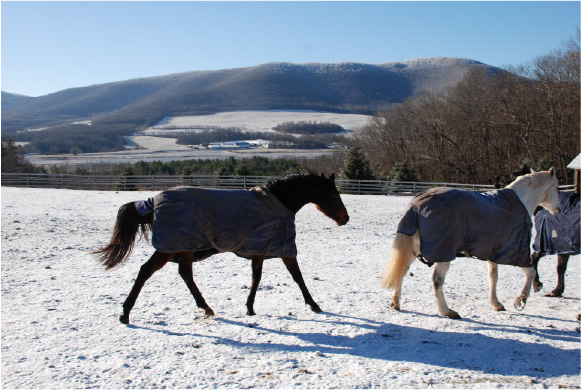
Drifting snow can be managed with the installation of temporary snow fences. Plastic snow fence can be set alongside driveways at a 20’ + distance and T-posts offer a quick and easy solution for support.
Preparation of high traffic areas such as gateways with a well-drained, well- compacted surface across a broad apron on either side of the gate, will improve access as snow melts and prevent muddy mayhem in Spring months or January thaws.
Gravel that is then surfaced with compacted stonedust is an option for gateways, as are various products available on the market that involve interlocking mat designs some of which can be backfilled with material across their grid construction.
Ice Is The Enemy
The slow melt of snow especially by the sun and refreezing of the surface traps moisture that can yield ice rink conditions. Ice is obviously a hazard to both horse and human.
Horses that go down on ice can suffer life-threatening injuries such as broken pelvis, broken legs etc. and their human caregivers can similarly find themselves injured.
Innovative ideas such as throwing down warm horse manure and bedding by the shovel full are commonly used to address an icy walkway. The use of salt and brine, chemical de-icers etc. should be carefully researched for the damage they can do not only to concrete or matted surfaces, but also the risks they pose as poisons to animals.
It is not wise to take your grass seeder and spray the paddock with crystals of de-icer or salt, even if the product used is not poisonous to animals. Ingestion of large quantities of these products can occur, especially if placed in hay feeding spaces within the paddock. Horses’ hooves can track the product into the barn and into stalls, where it may do further damage. Consider the other animals in your care such as cats and dogs, and always keep such items stored safely away from both pets and children.
Also consider the detrimental effects that may occur to the horses’ hooves if they are constantly walking or standing on de-icing products.
Snow removal completed as the snow is falling or has just fallen helps to prevent compaction of the snow that occurs as the sun heats the top layer of the snow or rain packs it down. This early removal can help prevent icing as the snow can be more easily plowed out of the way to base level when light and fluffy.
However, light and fluffy snow also increases the risk for snow drifts when high winds kick in. For this reason it is best to remove snow as far away as possible from major areas of ingress/egress.
Take A Load Off
The weight of snow on the roof of a horse barn, indoor arena or other structure can be significant and cause a multitude of problems if not properly addressed.
All structures should to be designed to meet or exceed the snow load building code for the geographic region in which they are situated, regardless of whether there are local ordinances in place to require them. Catastrophic collapse of large and small roofs happen every year and horses and humans do get hurt.
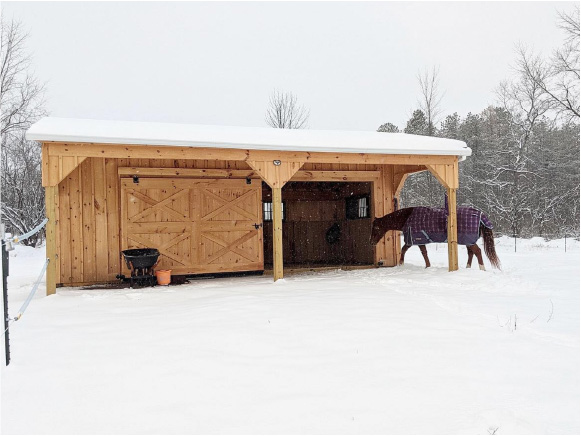
Construction of roof support components such as rafters, trusses, headers etc. must be sufficient to handle the duress of snow load. Certain roof overlay materials will shed snow load more quickly than others, and the pitch of the roof is determined in part by building code and in part by material utilized. For example, shingle does not shed the snow as effectively as metal/tin.
Melting snow that re-ices on shingle during periods of snowmelt, may cause an ice dam along the eves of the roof. The likelihood of the development of ice dams is more likely on a low-pitched roof than for one that is of a higher ratio pitch.
Ice dams cause a backlog of water that can permeate to the underlay of a roof and even migrate to the interior of a structure and cause water damage. Structures can be designed with a ridge vent and continuous soffit vents to help prevent ice dam formation. This is because the system will circulate cold air under the entire roof to keep the roof cold and prevent snow from melting and ice dams from forming.
Metal roofs on the other hand, can shed the snow and ice so rapidly that it presents a hazard to horses and humans below.
Build up of icicles on the roof edge may look pretty shining in the sun, but when they drop their spear like form to the ground that can also present a hazard.
Application of heated cables, ice metal panels, ice and water shield and a myriad of other ‘fixes’ are available to remedy the situation, but it is smart to anticipate these issues during the design phase of a horse barn if possible.
Door Placement
Gravity inevitably wins out and snow will end up sliding off roof and thumping on the ground, where it will pile up and melt slowly as winter temperatures recede.
Drainage around the building and grading of the apron away from the exterior walls of the structure are essential to prevent flooding backfilling stalls and the interior of the horse barn.
The main doorways to the horse barn should be set on the gable ends of the building to avoid the issue of snow blocking entryways.
Horse Barn Design Tips For Snowy Regions
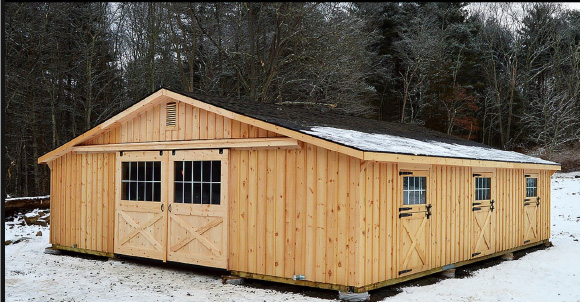
There are many features and design points that can be included in a new horse barn design to counteract adverse winter weather issues. Here is a selection of articles to help you help you figure out the best options:
· Don’t Forget The Overhang ~ One of the cheapest additions you can make to an existing plan design that makes a significant improvement in daily use of the barn.
· Why Did You Put It There ~ Forward planning makes all the difference when it comes to site selection.
· It’s Not Too Late For Fall Clean-Up ~ Prepping for winter includes removing unnecessary obstacles within and without the barn and a bunch more…
· Winter Horse Care & A Warm Barn ~ Winter preps to avoid disasters.
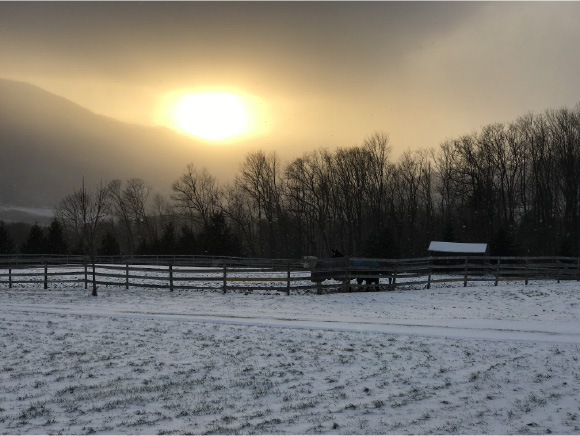
This article courtesy of Horizon Structures LLC, Atglen, PA., leading producer of modular horse barns, offering nationwide delivery.


